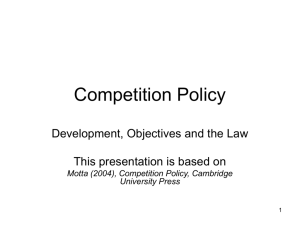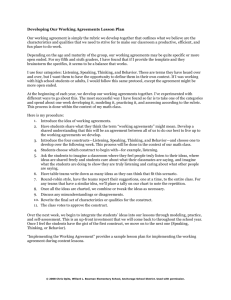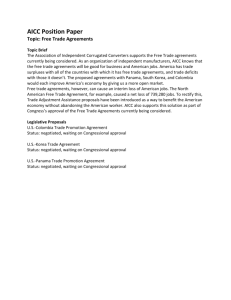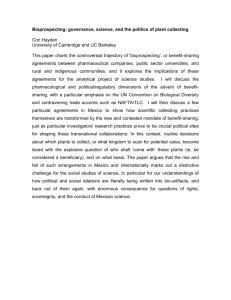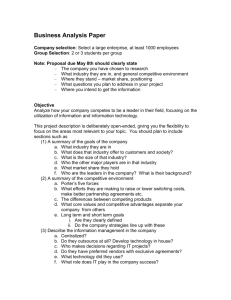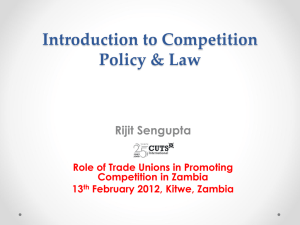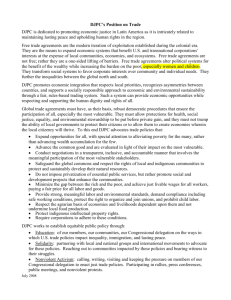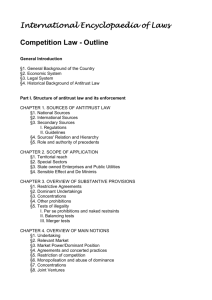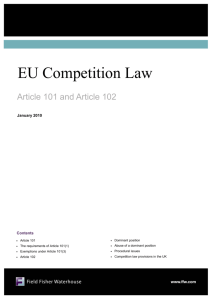Competition Policy: Introduction
advertisement
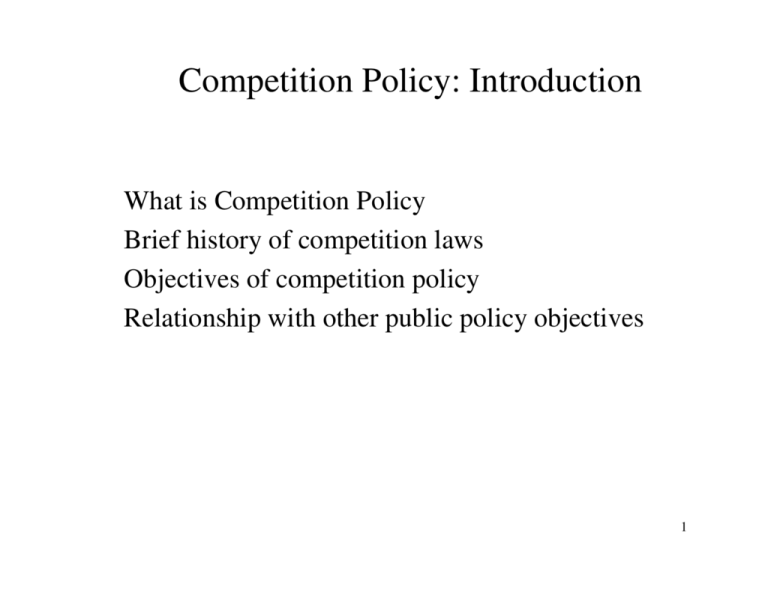
Competition Policy: Introduction What is Competition Policy Brief history of competition laws Objectives of competition policy Relationship with other public policy objectives 1 What is competition policy? Definition: Competition Policy aims at ensuring that competition in the marketplace is not restricted in a way that is detrimental to society Why do we need a competition policy? Market failure also in markets without natural monopoly features. Even if entry is possible, dominant positions might persist, due to: • sunk costs industries • lock-in effects and switching costs • network effects 2 What is competition policy, II We need competition policy also because: Un-monitored, firms may resort to actions that increase their profits, but harm society, such as: • • • • Collusion Mergers which lessen competition Predatory behaviour Exclusionary behaviour 3 Competition policy vs. regulation Both justified by market failures, but they differ by: Procedures and control rights • Regulation: more extensive powers (price, investments, products…), intervenes on market structure Timing of oversight • C.P.: ex-post; regulation: ex-ante • C.P.: usually more time • Occasional vs. continuous intervention Information intensiveness • Industry-specific for regulation 4 Demarcation lines become fuzzier Despite these differences, the distinction between competition and regulation is less clearcut: Merger control: preventive authorization system Merger remedies (Structural vs. behavioral remedies) Exploitative abuses (EU: article 82; not US) Also: overlapping competence in several areas 5 History of competition laws: the US End of XIX Century in the US: • Revolution in transportation and communication, which lead to a single US market • Technological innovations, stock market, new managerial methods economies of scale and scope to be reaped: firms’ size increases (also through mergers) 6 History of US law, II • Market instability, due to macroeconomic crises and price wars (and also by phenomena above) incentives to form cartels and trusts negative effects on farmers and small firms 1890: Sherman Act • Section 1: Conspiracies • Section 2: Monopolisation (1914: Clayton Act - mergers, price discrimination - and Federal Trade Commission Act) 7 History, III: Enforcement in the US 1897: first Supreme Court decisions against trusts 1911: Standard Oil broken into 34 firms Per se prohibition of price agreements (initially, little distinction btw. horizontal and vertical agreements) 1933: Appalachian Coals v. US, an exception 1950-60s: (too) active enforcement 1970s: efficiency criteria begin to play a role 1980s: (Reagan): laissez-faire... 8 History, IV: Germany End XIX Century: cartels (enforceable contracts) as a means to avoid cut-throat competition 1923: Cartel law as reaction to hyperinflation 1930: Great Depression: compulsory cartel participation in sensitive sectors Nazi regime: cartels to prepare the war apparatus After ’45: Programme to break economic concentration (stopped with Cold War) 1957: Competition Law (ratio: protection of freedom of contract); Bundeskartellamt 9 History, V: European Communities Paris Treaty: (ECSC): no trade barriers, no discrimination • Rationale: equal access to resources; principles of free markets • Predecessor of current EU Competition Law: – Art. 65: prohibits agreements that distort trade – Art 66: prohibits abuse of dominant position – Art. 66: concentrations 10 History, VI: European Comm. (cont.) Treaty of Rome (now Amsterdam): articles 81, 82 (and 83-89). Merger Regulation. Which objectives of Competition Law in the EU? • Competition as an intermediate objective (towards the primary objective: to help economic progress and welfare of European citizens) • European Integration (elimination of national discriminations in the economic system) 11 Article 81 of the EC Treaty The following shall be prohibited as incompatible with the common market: all agreements between undertakings, decisions by associations of undertakings and concerted practices which may affect trade between Member States and which have as their object or effect the prevention, restriction or distortion of competition within the common market, and in particular those which: (a) directly or indirectly fix purchase or selling prices or any other trading conditions; (b) limit or control production, markets, technical development, or investment; (c) share markets or sources of supply; (d) apply dissimilar conditions to equivalent transactions with other trading parties, thereby placing them at a competitive disadvantage; (e) make the conclusion of contracts subject to acceptance by the other parties of supplementary obligations which, by their nature or according to commercial usage, have no connection with the subject of such contracts. (Continue, p.t.o.) 12 Article 81, cont.: 81(2) and 81(3) Any agreements or decisions prohibited pursuant to this Article shall be automatically void. The provisions of paragraph 1 may, however, be declared inapplicable in the case of: - any agreement or category of agreements between undertakings; - any decision or category of decisions by associations of undertakings; - any concerted practice or category of concerted practices, which contributes to improving the production or distribution of goods or to promoting technical or economic progress, while allowing consumers a fair share of the resulting benefit, and which does not: (a) impose on the undertakings concerned restrictions which are not indispensable to the attainment of these objectives; (b) afford such undertakings the possibility of eliminating competition in respect of a substantial part of the products in question. 13 A single article, but different agreements Article 81 does not distinguish between agreements between competitors (horizontal agreements) and agreements between firms which operate at successive stages of the production process (vertical agreements). Economics: horizontal and vertical agreements should be treated in a different way. 1. Cartels and horizontal agreements 2. Vertical agreements 14 Article 82 of the EC Treaty Any abuse by one or more undertakings of a dominant position within the common market or in a substantial part of it shall be prohibited as incompatible with the common market insofar as it may affect trade between Member States. Such abuse may, in particular, consist in: (a) directly or indirectly imposing unfair purchase or selling prices or other unfair trading conditions; (b) limiting production, markets or technical development to the prejudice of consumers; (c) applying dissimilar conditions to equivalent transactions with other trading parties, thereby placing them at a competitive disadvantage; (d) making the conclusion of contracts subject to acceptance by the other parties of supplementary obligations which, by their nature or according to commercial usage, have no connection with the subject of such contracts. 15 Possible objectives of Comp. Law Economic Welfare (Total Surplus) Definition: W=CS+PS (+ …) If price falls, welfare rises Size of the pie, not how slices are distributed Dynamic aspects important (future W matters) Consumer Surplus CS v. W: lobbying arguments; who owns the firms?; If price equals marginal cost, who pays the fixed costs?; Who innovates and invests? Anyhow: usually, W and CS move together 16 Other possible objectives Defence of smaller firms Promoting market integration Protection of economic freedom Fighting inflation Fairness and equity Public policy considerations affecting competition Social, political, environmental reasons Strategic reasons (trade and industrial policies) 17
